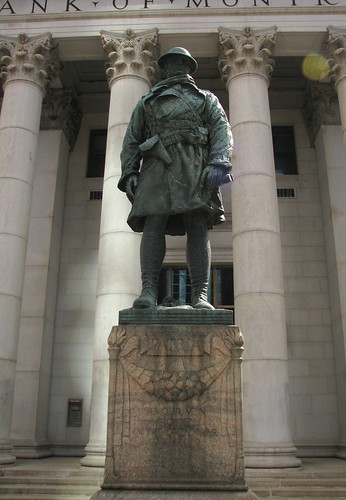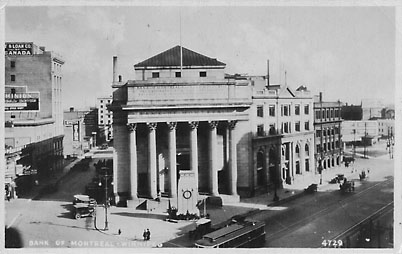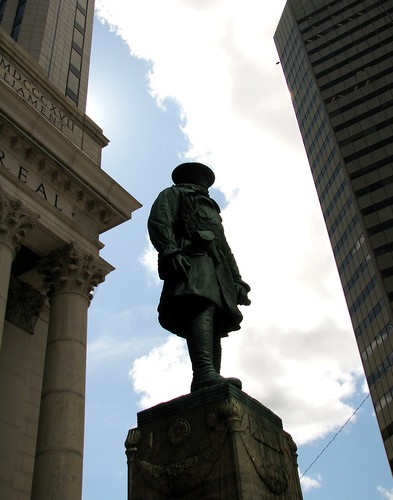© 2009, updated 2024, Christian Cassidy
Object: First World War Soldier (Bank of Montreal Memorial)
Location: Portage Avenue and Main Street
Unveiled: December 5, 1923
Artist: James Earle Fraser
Background
The nine-foot tall bronze monument that has peered down on Portage and Main for nearly a century is unnamed, known as "First World War Soldier" or the Bank of Montreal memorial. It was commissioned by the bank to commemorate their employees who died in action in World War I. In all 1,409 employees served and 230 never returned. In Winnipeg, the number was 53 served and nine 9 killed.
Above: Temporary cenotaph ca. 1922 (source)
Below: With "Soldier" ca. 1940 (source)
The bank held an international competition for the creation of two memorials - one for its Montreal headquarters and the other for Winnipeg. Some histories say that "Soldier" was originally envisioned for Montreal until the artist saw the interior of that bank and designed "Victory" in white marble to contrast its dark columns.
The spot chosen for the memorial was out front of the bank's imposing Winnipeg headquarters at Portage and Main. To prepare the space, the stairs and sidewalk needed to be rebuilt and Winnipeg's temporary cenotaph was removed.
Erected in 1920 by the Women's Canadian Club, the temporary cenotaph was modeled after the one unveiled in London earlier that year. The bank agreed to provide the space and raise and lower the flag each day, while the WCC looked after the flowers and overall care.
It was only meant to last a couple of years until the city's permanent cenotaph was built. That project, however, got mired in controversy and delays so World War One Soldier ended up standing in as the city's main memorial for Armistice Day 1922. (The following year, the Soldiers' Relatives / Next of Kin Memorial was unveiled on the Legislative grounds and took over central memorial duties until the the city's permanent cenotaph was finally unveiled in 1928).
A 2001 biography of the American artist James Earle Fraser describes Solider this way: “Here is no giant warrior god on a high pedestal, but a man. He is tough, ready for the fight, his feet apart, arms held loosely by his sides ready. His helmet is just slightly at an angle, and, under its brim, his face reflects strength and determination”
On one side of the marble pedestal are the words: "To Our Men Who Fell in The Great War 1914 - 1919", and on the other "Patria", or country.
Obviously meant to depict a Canadian, some have pointed out that the uniform and kit is more like that of an American First World War soldier.
December 5, 1923, Winnipeg Tribune
First World War Soldier / the Bank of Montreal memorial was unveiled at 4 pm on December 5, 1923.
It was a simple, intimate ceremony as the bank's management, including branch manager A. F. D. MacGachen, wanted it to be for the bank's staff and the families of the fallen employees rather than the city as a whole. He said of the memorial:
"...it typifies the heroic spirit which actuated all the soldiers of Western Canada - not merely those whose civilian service was with the Bank of Montréal"
December 5, 1923, Manitoba Free Press
The soldier has missed only a couple of years of duty. In April 1977 it was removed for safekeeping while the Portage and Main Concourse was constructed.
The time capsule in the marble base was opened to reveal newspapers, coins and bank memorabilia from 1923. New material was added to the old when the box was resealed.
The Artist

The artist is celebrated American sculptor James Earl Fraser who won an international competition for this memorial.
Fraser created some very celebrated U.S. statues including The End of the Trail (above) for the San Fransisco Exposition of 1915, the figures at the north and south base of the US Supreme Court, General Patton at West Point and the Benjamin Franklin for his National Memorial in Philadelphia.
The Model
The model for the statue was Captain Wynn Bagnall, a Bank of Montréal employee likely from the bank's main branch in Montreal, (definitely not from a Winnipeg branch).
Bagnall was born February 10, 1890 in Northumberland, England and enlisted as a gunner in the 6th Battery, Canadian Field Artillery at Valcartier, Quebec on September 22, 1914.
According to a 1921 Bank of Montreal biography, he went to France in 1915 then, "In January, 1916, he was given his commission as Lieutenant in the 23rd Battery, C.F.A., and was later attached to the 5th Battery. During 1917 he acted as Orderly Officer and Adjutant in the 2nd Brigade, C.F.A. In March, 1918, he was promoted to Captain and transferred to the 58th Battery, C.F.A. In October, 1918, he was awarded the Military Cross for conspicuous bravery in action."
Bagnall survived the war, 25 others from his branch did not, and returned to work for the bank briefly. It appears that after a return visit to England, he then immigrated to the U.S. in 1922. He died on March 12, 1931 and is buried in Cypress Hills National Cemetery in New York.
2024 UPDATE:
It was announced in October 2024 that the memorial will be moved from Portage and Main to allow for the redevelopment at Portage and Main. It will not return to the intersection when the work is done as the Bank of Montreal sold its iconic banking hall to the Manitoba Metis Federation in 2020.
"Soldier" will instead be relocated to the Brookside Cemetery Field of Honour, one of Canada's oldest and largest military cemeteries. Brookside was declared a national historic site in 2023.
Related
The Sculpture of James Earle Fraser (pdf)
The BMO Legacy BMO (pdf)
Bank of Montreal Celebrates 100th Anniversary of Historic Winnipeg Branch
Bagnall Sources
Memorial of the Great War, 1914-1918 : a record of service Bank of Montreal (1921)
Bagnall, Wynn Attestation Papers Library and Archives Canada
U.S. Veterans Honor Former CEF Veteran Edmonton Journal (1931)







No comments:
Post a Comment